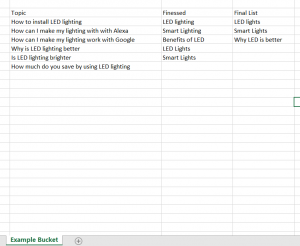How to do keyword planning – a simple guide
How to do keyword planning
This is going to be the first of several articles documenting the basics of pretty much every single discipline in a web project from inception to launch. I’m writing this to give some of my clients some key pointers – these posts aren’t in any way massively detailed nor do they contain any of the secret ‘sauce’ a professional like me would add, but you should be able to get a solid fundamental understanding of the logic and how it all works. In this article, I want to talk about how to do keyword planning.
The Background
I’ve been asked to produce a recommendation proposal for an e-commerce website. To be able to take the clients on a journey through the justification for things such as cost for advertising & the website itself, I like to back up (where I can) the statements & recommendations I make with data & insight. In this instance, what I’m trying to do is educate the client into their sector, what’s really happening online vs what they think is happening, and the where they should focus their marketing budget by doing some very simple keyword analysis in-house.
For this, you’ll need Microsoft Excel, SEM Rush and a few free tools available online. Keyword Shitter is pretty good, so is Google’s keyword Analyser, and Google Trends so we’ll go ahead & use those to help us with the planning.
Make a list of important relevant topics centred around your business.
You will want to consider what topics you want to ideally rank for, and put these into what we group (or bucket) lists. Come up with about 4-8 topic buckets you think are relevant to your business. Use those to then fill up with specific keywords you’ll research in more depth later. You will have to put yourself into the shoes of your customer, not yourself. Really think HARD about what your customer might search for, when using services or product similar you sell or offer, and/or where you’d like to appear in search listings, based on that.

Fill your buckets up.
Now is the time to use some actual keyword planning to identify the keywords which perform well and which will fall into those buckets. You are thinking what the customer would put into Google to search for your product or service. As an example, if I’m selling lightbulbs, I’d think about keyword phrases that I think people would type into Google, in relation to that topic. So;
- LED lighting
- Why is LED lighting better
- Where can I buy lightbulbs
- How do I know which lightbulb I need
And so on, and so on. You’re not coming up with your final list here, you’re ending up with a approximate list of phrases you’ll ultimately narrow down later on.
NOTE: Its sometimes worthwhile if you have an existing website, to use Google Analytics with some appropriate tracking to understand what keywords you’re currently being found for. This will help shape your strategy even further. In this case, this is a new website, so I don’t need to do that myself but I’d carry out this step for other projects where relevant.
Research any related terms
I use this step to educate myself about the sector if I don’t know a lot about it/or the client. Often I’m working in sectors or for clients I know nothing about – beds, deodorants, lady products etc. You want to be creative & explore the industry or sector, where is the attention, who are the influencers and what language are they using. In my example, the client is using the term ‘lamps’ but the world online doesn’t use that term anymore, they use the word ‘bulb’ . This is key insight we’d ultimately shape a PPC campaign around.
Ensure you mix your tails up
Ensure your buckets contain a mixture of both short & long-term keywords. Short being single words such as ‘bulb’ where a long tail term would be something like ‘replacement bulb for my cooker’. Its important you do this because you want your keyword strategy to be balanced to get the most potential ROI. Short terms are usually searched for more frequently making them often more competitive and harder to rank for than long tail terms – so you need to stay balanced to try & get the best of both. Make sense?
Competitor Keyword analysis.
Do the same research for your competitors to see how they rank for the same keywords. You need to understand the keywords which are important and seeing how your competitors rank for keywords is a great way to give your keyword list another look. Don’t blindly follow your competitors, but it’s best to keep an eye out.
SEM Rush is a great tool here to allow you to run free reports (up to 10 on my last check) showing keyword analysis for you against your competitors. I used this tool for this project and it was great to do some analysis for keywords and getting some solid relevant data back. I dropped that research into a slide deck I’ll ultimately show the client later.
Break out Google’s Keyword planner
Now you need to hone & finesse. Narrow those keywords down using quantitive data provided by a tool such as Keyword planner (Keyword shitter is also pretty good). You are looking for search volume and traffic estimates for keyword. This will help you determine which keywords are good bets to invest in. You can also use Google Trends to yep, plot trends and between the wo you should be able to flag which search terms have either two little (or two much) search volume. Remember, keep that balance. So strip out any outliers and you should start to have some nicely formed buckets of keywords.

In Summary
So now you should have some condensed and refined keywords that based on your research should ensure when budget is allocated to them or you use those terms in your copy organically or you focus authoritative content around those topics, you will generate traffic. From there, you can hopefully convert into sales.




